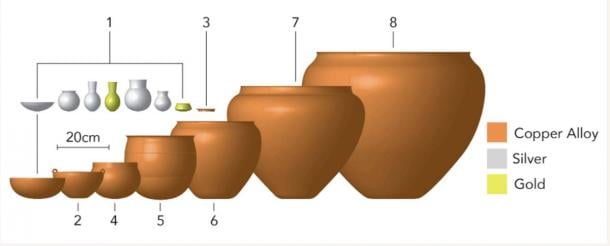
Savoring the Past: Bronze Age Cauldrons' Residues Unveil Caucasus Cuisine
An analysis of protein residues from the Caucasus region (the transcontinental region between the Black Sea and the Caspian Sea) from the Maykop period (3700-2900 BC), has revealed a menu of deer, sheep, goats, and bovine species, amongst others. These protein residues were found in ancient cooking Bronze Age cauldrons, and are an important window into understanding dietary habits, consumption, and food evidence, which have been tough to reconstruct due to absence of evidence.
Fusing Protein Analysis and Archaeology: A Landmark New Method
A new study in the journal iScience has taken a radical new approach that has fused protein analysis with archaeological investigation. This has helped uncover detailed information about culinary practices associated with specific vessels.
“It’s really exciting to get an idea of what people were making in these cauldrons so long ago,” says Shevan Wilkin of the University of Zurich. “This is the first evidence we have of preserved proteins of a feast—it's a big cauldron. They were obviously making large meals, not just for individual families.”
Historically, researchers have recognized that the fats trapped in ancient pottery and proteins discovered in dental calculus, the calcified plaque on teeth, can provide insights into the proteins consumed by ancient humans.
- 7,000-Year-Old Ceramic Fragment with Signs, Symbols and Swastika May Be One of the Oldest Examples of Writing
- Caucasus Societies Developed an Aversion to Gold “Bling,” Says Study
The remarkable preservation of proteins on these cauldrons is attributed to the antimicrobial properties inherent in many metal alloys. These alloys deter the microbial activity that typically breaks down proteins on surfaces like ceramics and stones.
“Direct investigation of the roles of metal vessels in prehistoric society is complicated by a number of factors, not least that of survival. With the exception of gold and silver, which preserve well in most conditions, other metal artifacts are susceptible to corrosion and post- depositional damage; thin-walled objects—having both a large surface area and a small cross-sectional area—tend to be the most vulnerable,” write the authors in the study.
Collection of Residue Samples and the Politics of Bronze Age Cauldrons
The team of researchers meticulously collected eight residue samples from seven cauldrons discovered at burial sites across the Caucasus region. This geographical expanse stretches from Southwestern Russia to Turkey, encompassing present-day countries such as Georgia, Azerbaijan, and Armenia.

Testing has been carried out on several Maykop Bronze Age cauldrons. (Wilkin et al. / iScience)
Their analysis successfully extracted proteins from sources like blood, muscle tissue, and milk. The presence of heat shock protein beta-1 suggests that the cauldrons were employed for cooking deer or bovine tissues. Additionally, milk proteins from either sheep or goats were identified, indicating the use of these cauldrons for dairy-related preparations.
“We have already established that people at the time most likely drank a soupy beer, but we did not know what was included on the main menu,” says Viktor Trifonov of the Institute for the History of Material Culture.
- Study Contradicts Top-Down Theories on Ancient Thai Metal Production
- What is this Ancient Perpetual Stew Being Served in a Brooklyn Park?
The application of radiocarbon dating enabled the researchers to precisely date the use of the cauldrons to a period between 3520–3350 BC. This revelation places these vessels in a historical context that predates any previously analyzed specimens by over 3,000 years.
“We would like to get a better idea of what people across this ancient steppe were doing and how food preparation differed from region to region and throughout time,” says Wilkin.
While the cauldrons bear marks of both wear and extensive repair, these characteristics hint at their significance. Evidently, these utensils held great value and necessitated exceptional craftsmanship to produce. In a way akin to contemporary premium cookware brands like Le Creuset or Mauviel, these cauldrons may have symbolized wealth or social status.

The recovery of preserved proteins in these archaeological samples has provided further insight regarding the diet across the Caucasus region. (Wilkin et al. / iScience)
“It was a tiny sample of soot from the surface of the cauldron,” says Trifonov. “Maykop bronze cauldrons of the fourth millennium BC are a rare and expensive item, a hereditary symbol belonging to the social elite.”
Looking ahead, the research team intends to broaden their investigation to encompass a wider range of vessel types. Given that cuisine forms an integral part of cultural identity, studies of this nature might unveil connections and disparities between diverse regions.
“If proteins are preserved on these vessels, there is a good chance they are preserved on a wide range of other prehistoric metal artifacts. We still have a lot to learn, but this opens up the field in a really dramatic way,” concluded Wilkin.
Top image: (a) Photograph of the cauldron and what is left today. (b) artistic reconstruction of the cauldron as it would have looked when in use. Source: Wilkin et al. / iScience
By Sahir Pandey
References
Wilkin, S., et al. 2023. Curated Bronze Age cauldrons: Preserved proteins from early copper alloy vessels illuminate feasting practices in the Caucasian steppe. iScience. Available at: 10.1016/j.isci.2023.107482 .















